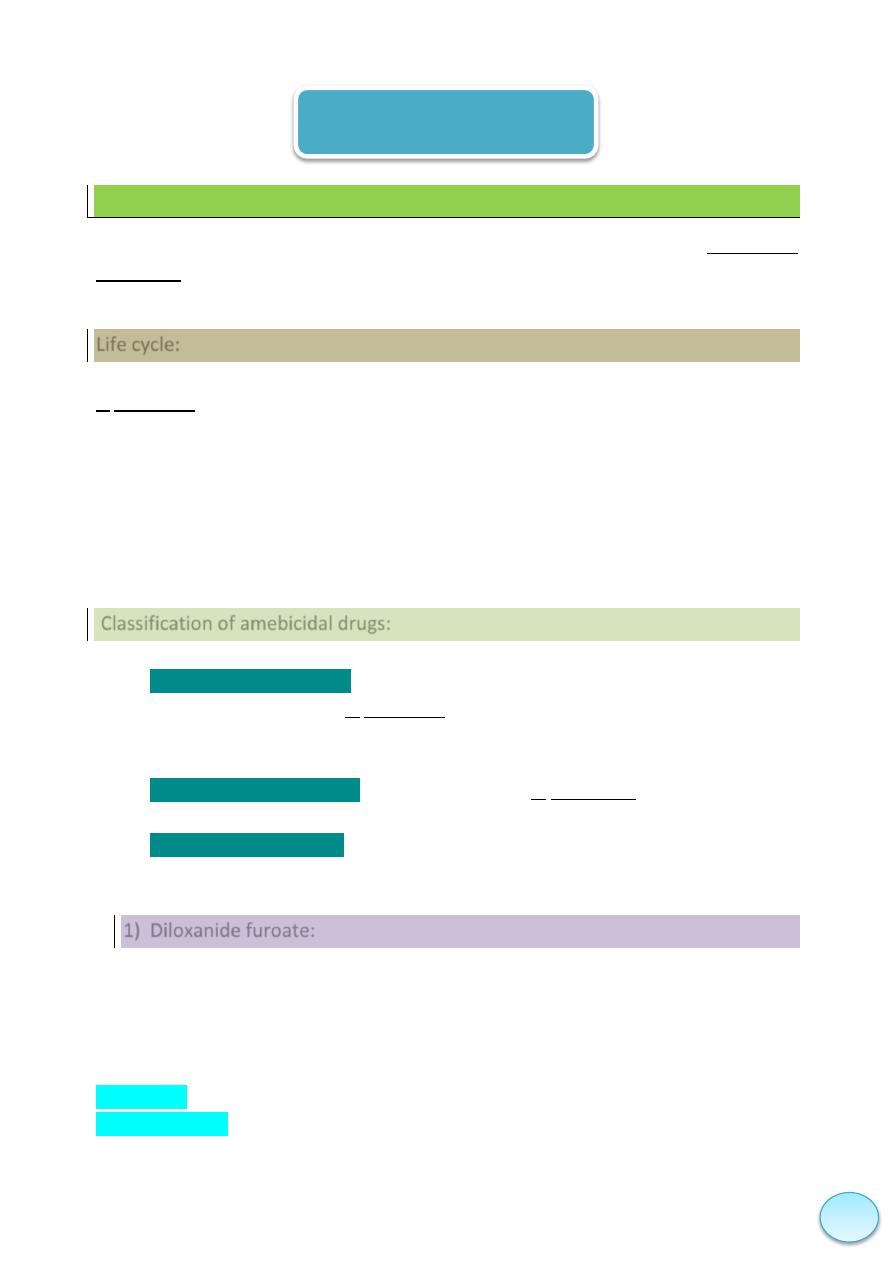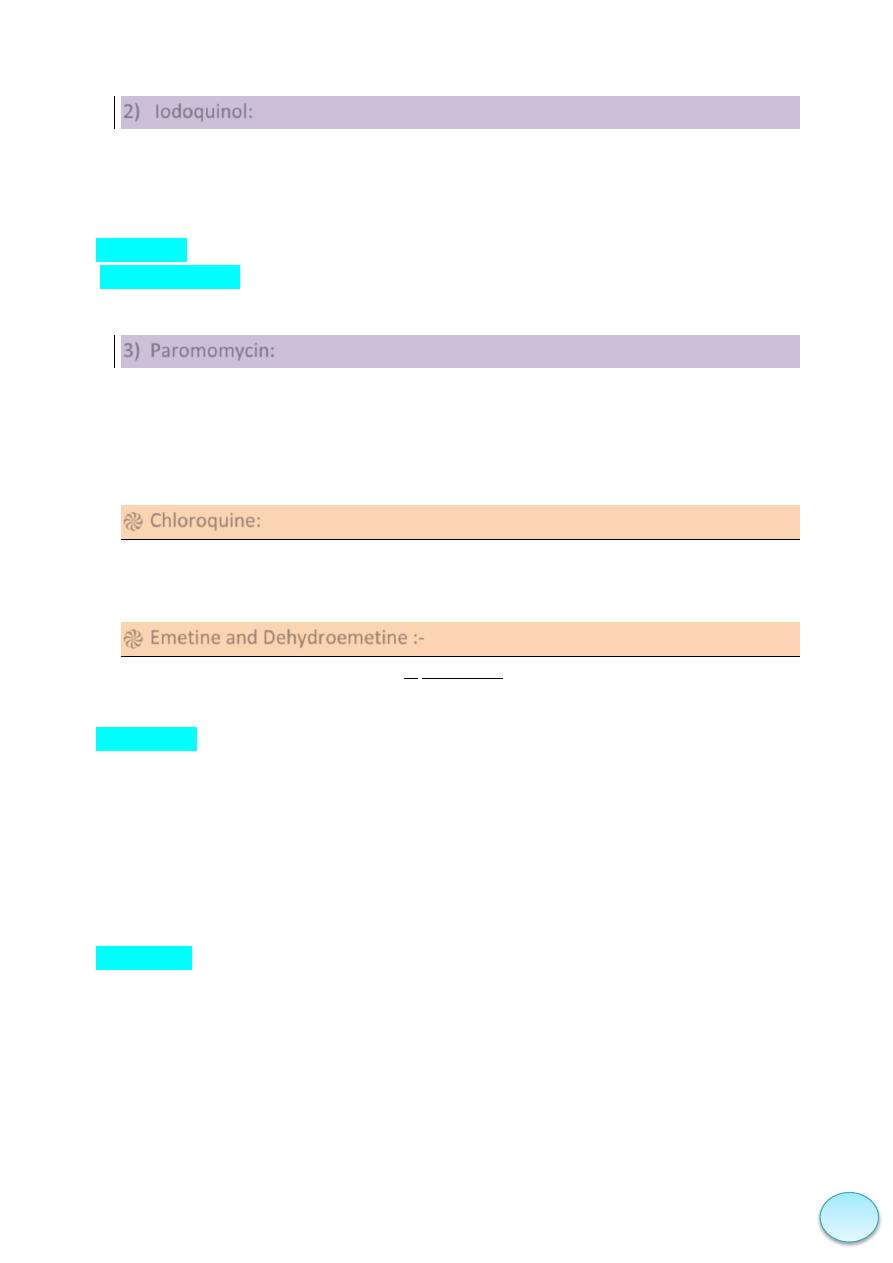
1
250
دينار
Amoebiasis
(also called amebic dysentery),is an infection of intestinal tract caused by Entamoeba
histolytica , the disease can be acute or chronic ,either asymptomatic (carrier) ,or mild to
moderate diarrhea or present as sever dysenteric diarrhea .
Life cycle:
E. histolytica exists in two forms .cyst, that can survive outside the body ,trophozoite that
don’t persist outside the body ,cyst ingested through contaminated food or water ,pass
into the lumen of intestine where trophozoites are liberated ,the trophozoites multiply
and they either invade and ulceration the mucosa of large intestine ,or simply feed on
intestinal bacterial flora ,the trophozoites within intestine are slowly carried toward the
rectum ,where they return to the cyst form again and are excreted in feces ,large numbers
of trophozoites within the colon wall can also lead to systemic invasion.
Classification of amebicidal drugs:
1.
Luminal amebicidal drugs
, act on the parasite in the lumen of intestine can kill the
cyst and trophozoites of E. histolytica in the lumen of intestine only and not effect
on trophozoites in the intestinal wall or extra intestinal tissues e.g. Diloxanide
furoate , Iodoquinol, Paromomycin .
2.
Systemic amebicidal drugs
, that’s effect against E. histolytica in the intestinal wall
and liver e.g. Chloroquine, Dehydroemetine, Emetine.
3.
Mixed amebicidal drugs
, (luminal and systemic effect against both luminal and
systemic amoebiasis e.g. Metronidazole.
1) Diloxanide furoate:
Effective luminal amebicidal drug, not effect against tissue trophozoites, in the gut the
drug splits or hydrolyzed in the intestinal mucosa into Diloxanide and furoic acid, the
unabsorbed Diloxanide (10%) is the active anti amoebic substance and 90% absorbed and
excreted in the urine.
Side effects flatulence, dryness of mouth, Pruritus and urticaria.
Contraindication in pregnant women and children under 2 years age.
Antiamebiac drugs

2
2) Iodoquinol:
It is halogenated 8-hydroxy quinolone ,it is effective luminal amebicidal against both cyst
and trophozoites of E. histolytica that present in the lumen of intestine and it is not effect
on trophozoites in the intestinal wall or extra intestinal tissues ,90% of the drug not
absorbed and the remainder enters the circulation .
Side effects: Rash, diarrhea, dose related neuropathy include optic neuritis.
Contraindications: the drug should use in caution in patients with impaired hepatic or
renal diseases or those with optic neuropathy.
3) Paromomycin:
An aminoglycoside antibiotic, only effective against luminal disease because it is not
significantly absorbed from GIT. Associated with gastric upset and diarrhea.
Systemic amebicidal drugs are useful for treatment intestinal wall infection and liver
amoebiasis include:
֎ Chloroquine:
It is used in combination with Metronidazole and Diloxanide furoate to treat and prevent
liver amoebiasis ,but it not useful in treatment luminal amoebiasis .
֎ Emetine and Dehydroemetine :-
Effective against tissue trophozoites of E. histolytica, but because of major toxicity almost
completely replaced by Metronidazole.
Clinical uses:
1) Treatment amoebic dysentery for minimum period to relief sever symptoms used
for 3-5 days.
2) Used as alternative therapy for amoebic liver abscess, in both above cases , a
luminal amoebiasis should be given ,they administered S. C. or I. M. ,but never I.
V. ,they accumulated in tissues ( can concentrated in the liver for a month after a
single dose ) ;it is slowly metabolized and slowly eliminated by the kidney ; half life
5 days .
Side effects:
1. Pain and tenderness at site of injection.
2. Diarrhea, nausea, and vomiting.
3. ECG changes and cardiac toxicity.
4. Neuromuscular weakness, dizziness and skin rash.

3
Leishmaniasis:
There are 3 types of leishmaniasis, cutenous, mucocutenous and visceral leishmaniasis
;the parasite transmitted from animals to human (and among humans ) by the bite of
infected sand flies.
The treatment of leishmaniasis done by Sodium stibogluconate (Pentostam)
R
; it is act by
inhibit glycolysis in the parasite ,considered first line drug in treatment of cutenous and
visceral leishmaniasis and because it not absorbed orally ,it must administered
parentally((I.M. or I. V.) ; it is distributed to all body tissues and excreted in the urine .
Given once daily at dose of 20mg /Kg /day I. V. or I. M. for 20 days in cutenous
leishmaniasis and for 28 days for mucocutenous and visceral leishmaniasis .
Pentamidine is an alternative to sodium stibogluconate for treatment of visceral
leishmaniasis.
Side effects:
1. Pain at site of injection.
2. GIT upset.
3. Cardiac arrhythmias.
4. Haemolytic anaemia.
5. Serious liver, renal, and cardiac effect are rare.
